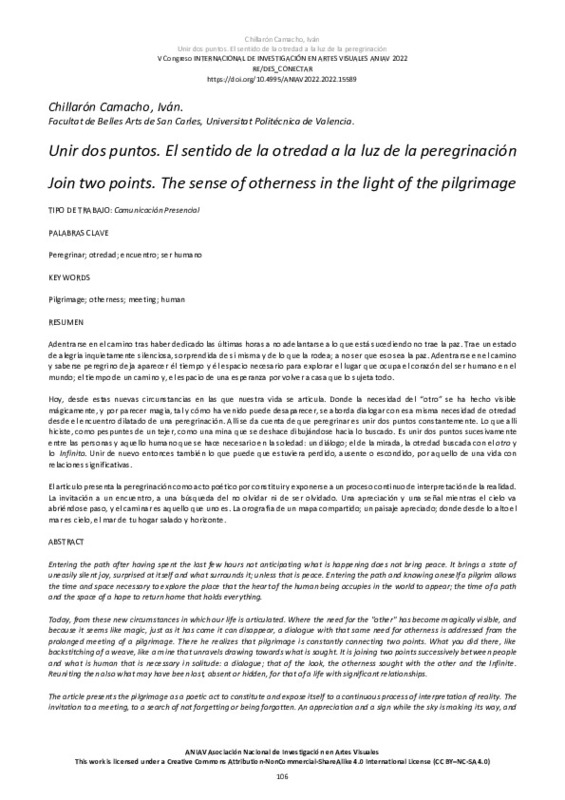|
Resumen:
|
[EN] Entering the path after having spent the last few hours not anticipating what is happening does not bring peace. It brings a state of
uneasily silent joy, surprised at itself and what surrounds it; unless that is ...[+]
[EN] Entering the path after having spent the last few hours not anticipating what is happening does not bring peace. It brings a state of
uneasily silent joy, surprised at itself and what surrounds it; unless that is peace. Entering the path and knowing oneself a pilgrim allows
the time and space necessary to explore the place that the heart of the human being occupies in the world to appear; the time of a path
and the space of a hope to return home that holds everything.
Today, from these new circumstances in which our life is articulated. Where the need for the "other" has become magically visible, and
because it seems like magic, just as it has come it can disappear, a dialogue with that same need for otherness is addressed from the
prolonged meeting of a pilgrimage. There he realizes that pilgrimage is constantly connecting two points. What you did there, like
backstitching of a weave, like a mine that unravels drawing towards what is sought. It is joining two points successively between people
and what is human that is necessary in solitude: a dialogue; that of the look, the otherness sought with the other and the Infinite.
Reuniting then also what may have been lost, absent or hidden, for that of a life with significant relationships.
The article presents the pilgrimage as a poetic act to constitute and expose itself to a continuous process of interpretation of reality. The
invitation to a meeting, to a search of not forgetting or being forgotten. An appreciation and a sign while the sky is making its way, and walking is what one is. The orography of a shared map; an appreciated landscape; where from above the sea is sky, the sea of your salty
home and horizon.
[-]
[ES] Adentrarse en el camino tras haber dedicado las últimas horas a no adelantarse a lo que está sucediendo no trae la paz. Trae un estado de alegría inquietamente silenciosa, sorprendida de sí misma y de lo que la rodea; ...[+]
[ES] Adentrarse en el camino tras haber dedicado las últimas horas a no adelantarse a lo que está sucediendo no trae la paz. Trae un estado de alegría inquietamente silenciosa, sorprendida de sí misma y de lo que la rodea; a no ser que eso sea la paz. Adentrarse en el camino y saberse peregrino de vuelta al hogar deja aparecer él tiempo y él espacio necesarios para explorar el lugar que ocupa el corazón del ser humano en el mundo; el tiempo de un camino y, el espacio de una esperanza por volver a casa que lo sujeta todo. Hoy, desde estas nuevas circunstancias en las que nuestra estructura de vida se articula. Donde la necesidad del “otro” se ha hecho visible mágicamente, y por parecer magia, tal y cómo ha venido puede desaparecer, se aborda dialogar con esa misma necesidad de otredad desde el encuentro dilatado de una peregrinación. Allí se da cuenta de que peregrinar es unir dos puntos: el de partida y el de llegada. Lo que allí hiciste, como pespuntes de un tejer, como una mina que se deshace dibujándose hacia lo buscado. Es unir dos puntos sucesivamente entre las personas y aquello humano que se hace necesario en la soledad: un diálogo; el de la mirada, la otredad buscada. Unir de nuevo entonces también lo que puede que estuviera perdido, ausente o escondido, por aquello de una vida con relaciones significativas. El artículo presenta a través del trabajo artístico personal y la reflexión a la peregrinación como acto poético por constituir y exponerse a un proceso continuo de interpretación de la realidad que deviene en algo más. Uno se invita es a un encuentro, a una búsqueda del no olvidar ni de ser olvidado. Una apreciación y una señal mientras el cielo va abriéndose paso, y el caminar es aquello que uno es. La orografía de un mapa compartido; un paisaje apreciado; donde desde lo alto el mar es cielo, el mar de tu hogar salado y horizonte.
[-]
|








